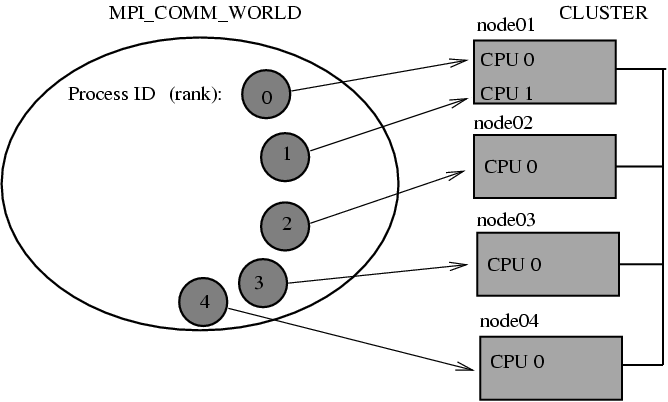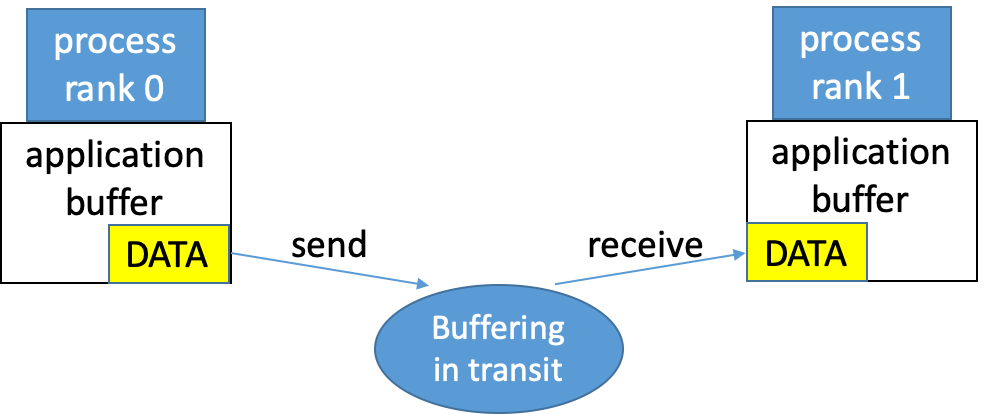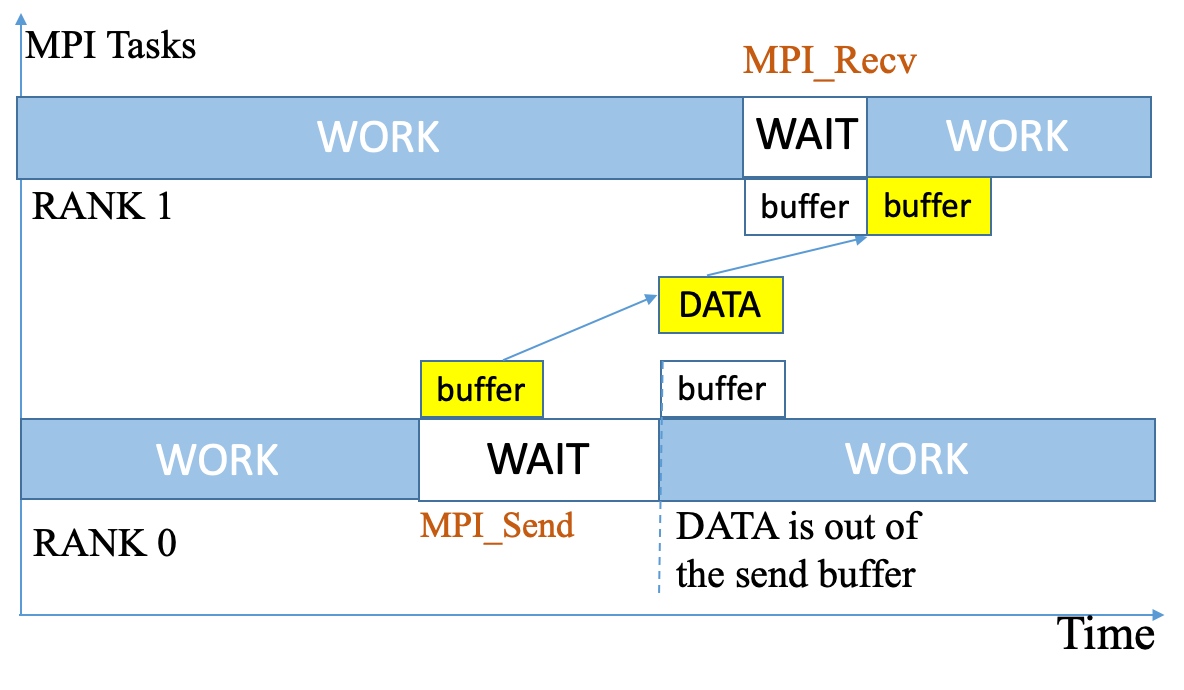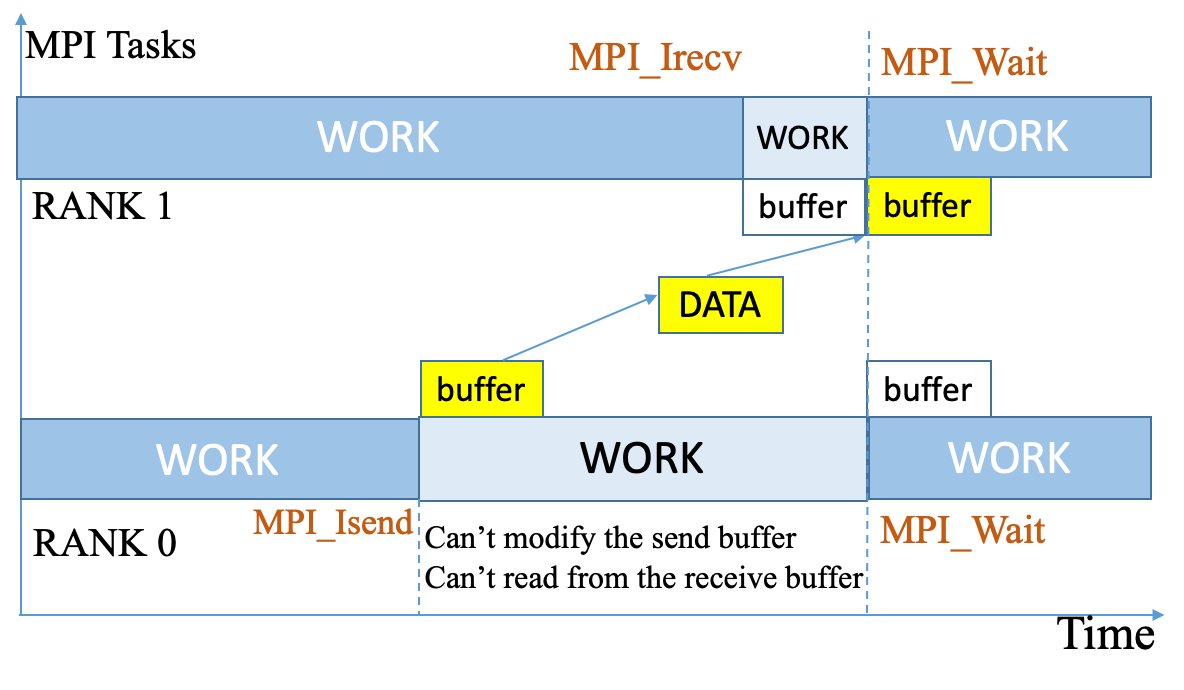MPI
Contents
MPI¶
Part II: MPI
Outline of the presentation¶
What is MPI and how it works
MPI program structure
Environment management routines
How to compile and run MPI program
MPI point-to-point communications Blocking and non-blocking send/receive routines
MPI collective communication routines MPI_Reduce example
Domain decomposition and MPI task farming
MPI lab exercises review
Message Passing Interface (MPI)¶
Processes run on network distributed hosts and communicate by exchanging messages.
A community of communicating processes is called a Communicator. MPI_COMM_WORLD is the default.
Inside the communicator, each process is assigned its rank.
Each process runs the same code (SPMD model)

How an MPI Run Works¶
Every process gets a copy of the same executable: Single Program, Multiple Data (SPMD).
They all start executing it.
Each process works completely independently of the other processes, except when communicating.
Each looks at its own rank to determine which part of the problem to work on.
MPI is SPMD¶
To differentiate the roles of various processes running the same MPI code, you have to have if statements for the rank number. Often, the rank 0 process is referred as a master, and the other as a worker.
if (my_rank == 0) {
//do the master tasks
}
# similarly,
if (my_rank != 0) {
//do the worker tasks
}
General MPI program structure¶
MPI include header file #include "mpi.h"
Initialize MPI environment
Main coding and Message Passing calls
Terminate MPI environment
Major Environment Management Routines¶
// Data initialization
MPI_Init (&argc, &argv) //MPI initialization
MPI_Comm_size (comm, &size) //Learn the number prticipating processes
MPI_Comm_rank (comm, &rank) //Learn my rank
// Some work is done here
// Some MPI message passing involved
MPI_Abort (comm, errorcode) //Terminate MPI at some conditions
MPI_Get_processor_name (&name, &resultlength) //Learn my processr name
MPI_Finalize () //Complete the MPI run
MPI code template without send/receive.¶
Each process initializes the MPI environment, then prints out the number of processes, its rank, and the hostname
#include "mpi.h"
#include <stdio.h>
int main(int argc, char *argv[]) {
int numtasks, rank, len, rc;
char hostname[MPI_MAX_PROCESSOR_NAME];
// initialize MPI
MPI_Init(&argc, &argv);
// get MPI process rank, size, and processor name
MPI_Comm_size(MPI_COMM_WORLD, &numtasks);
MPI_Comm_rank(MPI_COMM_WORLD, &rank);
MPI_Get_processor_name(hostname, &len);
printf ("Number of tasks= %d My rank= %d Running on %s\n", numtasks, rank, hostname);
// Here we can do some computing and message passing ….
// done with MPI
MPI_Finalize();
}
MPI compilation and run examples¶
mpicc -o hello.x hello.c
To run the executable with 8 tasks on the same node:
mpirun -n 8 hello.x
To run the executable across 8 CPUs via SLURM on a cluster:
srun -n 8 hello.x
To run the executable across 2 nodes, 8 CPUs, and without a queue system:
mpirun -n 8 -hostfile nodes.txt hello.x
The hostfile, nodes.txt, defines CPU allocation, for example: nodes.txt
node01 slots=4
node02 slots=4
MPI point-to-point communications¶
In two communicating MPI processes, one task is performing a send operation and the other task is performing a matching receive operation.
Blocking send/receive calls:
MPI_Send(&buffer, count, type, dest, tag, comm)
MPI_Recv(&buffer, count, type, source, tag, comm, status)
in MPI_Send
buffer – data elements, variables
count – the number of elements
type – MPI data type
dest - rank of the receiving process
tag – int number, unique msg id
comm – communicator
in MPI_Recv
buffer – data elements, variables
count – the number of elements
source – rank of the sending proc
tag – int number, unique msg id
comm – communicator
status - communication status
Some most commonly used MPI data types¶
MPI C/C++ data types |
C/C++ data types |
|---|---|
MPI_INT |
int |
MPI_LONG |
long int |
MPI_LONG_LONG |
long long int |
MPI_CHAR |
char |
MPI_UNSIGNED_CHAR |
unsigned char |
MPI_UNSIGNED |
unsigned int |
MPI_UNSIGNED_LONG |
unsigned long int |
MPI_UNSIGNED_LONG_LONG |
unsigned long long int |
MPI_FLOAT |
float |
MPI_DOUBLE |
double |
MPI_LONG_DOUBLE |
long double |
There are also other data types in MPI.
MPI also allows user defined data types.
Blocking send/receive example¶
Two processes with rank 0 and 1 initialize variables and the MPI environment, then the process of rank 0 sends a message to the rank 1 process
if (rank == 0) {
//send a message to proc 1
dest = 1;
MPI_Send(&outmsg, 9, MPI_CHAR, dest, tag, MPI_COMM_WORLD);
}
if (rank == 1) {
//receive a message from proc 0
source = 0;
MPI_Recv(&inmsg, 9, MPI_CHAR, source, tag, MPI_COMM_WORLD, &Stat);
}
Blocking MPI send/receive code example.¶
Each process initializes the MPI environment, then process with rank 0 sends “LCI_2022” string to rank 1
#include "mpi.h"
#include <stdio.h>
int main(int argc, char *argv[]) {
int numRanks, rank, dest, source, rc, count, tag=222;
char inmsg[9], outmsg[9]="LCI_2022";
MPI_Status Stat;
MPI_Init(&argc,&argv);
MPI_Comm_size(MPI_COMM_WORLD, &numRanks);
MPI_Comm_rank(MPI_COMM_WORLD, &rank);
if (rank == 0) {
dest = 1;
MPI_Send(&outmsg, 9, MPI_CHAR, dest, tag, MPI_COMM_WORLD);
}
else if (rank == 1) {
source = 0;
MPI_Recv(&inmsg, 9, MPI_CHAR, source, tag, MPI_COMM_WORLD, &Stat);
printf("Rank %d Received %s from Rank %d \n", rank, inmsg, source);
}
MPI_Finalize();
Compiling and running the MPI blocking send/receive code¶
mpicc -o b_send_receive.x b_send_receive.c
mpirun -n 2 b_send_receive.x
output:
Rank 1 Received LCI_2022 from Rank 0
Task 1: Received 9 char(s) from task 0 with tag 222
MPI send/receive buffering¶
The MPI implementation (not the MPI standard) decides what happens to data between send/receive. Typically, a system buffer area is reserved to hold data in transit.

The blocking send/receive work flow¶
MPI_Send returns after it is safe to modify the send buffer.
MPI_Recv returns after the data has arrived in the receive buffer.

MPI non-blocking send/receive¶
The process of rank 0 sends a message to the rank 1 process via MPI_Isend, then continues running.
The rank 1 process may retrieve the data from the buffer later via MPI_Irecv.
Neither the send buffer can be updated, nor the receive buffer can be read until the processes make a synchronization call, MPI_wait.
if (rank == 0) {
//send a message to proc 1
dest = 1;
MPI_Isend(&outmsg, 9, MPI_CHAR, dest, tag, MPI_COMM_WORLD, &request);
}
if (rank == 1) {
//receive a message from proc 0
source = 0;
MPI_Irecv(&inmsg, 9, MPI_CHAR, source, tag, MPI_COMM_WORLD, &request);
}
MPI_wait(&request, &Stat);
The non-blocking send/receive work flow¶
The MPI_Isend returns right away, and the rank 0 process continues running. The rank 1 process may call MPI_Irecv later. The send buffer shouldn’t be updated and the receive buffer shouldn’t be read until MPI_Wait is called by the both tasks.

Non-Blocking MPI send/receive code example.¶
Each process initializes the MPI environment, then process with rank 0 sends “LCI_2022” string to rank 1
#include "mpi.h"
#include <stdio.h>
int main(int argc, char *argv[]) {
int numRanks, rank, dest, source, rc, count, tag=222;
char inmsg[9], outmsg[9]="LCI_2022";
MPI_Status Stat; MPI_Request request = MPI_REQUEST_NULL;
MPI_Init(&argc,&argv);
MPI_Comm_size(MPI_COMM_WORLD, &numRanks);
MPI_Comm_rank(MPI_COMM_WORLD, &rank);
if (rank == 0) {
dest = 1;
MPI_Isend(&outmsg, 9, MPI_CHAR, dest, tag, MPI_COMM_WORLD, &request); }
else if (rank == 1) {
source = 0;
MPI_Irecv(&inmsg, 9, MPI_CHAR, source, tag, MPI_COMM_WORLD, &request);
}
MPI_Wait(&request, &Stat);
if (rank == 1) { printf("Rank %d Received %s from Rank %d \n", rank, inmsg, source); }
MPI_Finalize();
}
Send/Receive order and “fairness”¶
Author: Blaise Barney, Livermore Computing.
Order:
MPI guarantees that messages will not overtake each other.
If a sender sends two messages (Message 1 and Message 2) in succession to the same destination, and both match the same receive, the receive operation will receive Message 1 before Message 2.
If a receiver posts two receives (Receive 1 and Receive 2), in succession, and both are looking for the same message, Receive 1 will receive the message before Receive 2.
Order rules do not apply if there are multiple threads of the same process participating in the communication operations.
Fairness:
MPI does not guarantee fairness - it’s up to the programmer to prevent “operation starvation”.
Example: task 0 sends a message to task 2. However, task 1 sends a competing message that matches task 2’s receive. Only one of the sends will complete.
MPI collective communications¶
So far, we have reviewed the basic point-to-point MPI calls, involving pairs of processes.
For efficient programming, there are collective communication functions that involve all processes in the communicator,
MPI_COMM_WORLD.Some frequently used Collective communications routines:
MPI_Barrier– blocks execution until all the tasks reach itMPI_Bcast– sends a message to all MPI tasksMPI_Scatter– distributes data from one task to allMPI_Gather– collects data from all tasks into oneMPI_Allgather– concatenation of data to all tasksMPI_Reduce– reduction operation computed by all tasks
MPI Collective communications data flow.¶

MPI_Reduce¶
Applies a reduction operation, op, on all processes (tasks) in the communicator, comm, and places the result in one task, root.
MPI_Reduce (&sendbuf,&recvbuf,count,datatype,op,root,comm)
sendbuf– data elements to send,recvbuf– reduce resultcount– the number of elementsdatatype– MPI data typeop– reduction operationroot– rank of the receiving proccomm– communicator
Predefined MPI Reduction operations¶
MPI Reduction |
operation |
MPI C data types |
|---|---|---|
MPI_MAX |
maximum |
integer, float |
MPI_MIN |
minimum |
integer, float |
MPI_SUM |
sum |
integer, float |
MPI_PROD |
product |
integer, float |
MPI_LAND |
logical AND |
integer |
MPI_BAND |
bit-wise AND |
integer, MPI_BYTE |
MPI_LOR |
logical OR |
integer |
MPI_BOR |
bit-wise OR |
integer, MPI_BYTE |
MPI_LXOR |
logical XOR |
integer |
MPI_BXOR |
bit-wise XOR |
integer, MPI_BYTE |
MPI_MAXLOC |
max value and location |
float, double and long double |
MPI_MINLOC |
min value and location |
float, double and long double |
Users can also define their own reduction functions by using the MPI_Op_create routine.
Example: MPI_Reduce for a scalar product¶
Scalar product of two vectors, \(\vec{A}\) and \(\vec{B}\):
sum = \((\vec{A} \cdot \vec{B})\) = \(A_0 \cdot B_0 + A_1 \cdot B_1 + … + A_{n-1} \cdot B_{n-1} \)
Have each task to compute partial sums on a chunk of data, then
do MPI_Reduce on the partial sums and write the result to the task of rank 0:
int chunk = Array_Size/numprocs; //how many elements each process gets in the chunk
for (i=rank*chunk; i < (rank+1)*chunk; ++i)
part_sum += A[i] * B[i]; //Each process computes a partial sum on its chunk
MPI_Reduce(&part_sum, &sum, 1, MPI_FLOAT, MPI_SUM, 0, MPI_COMM_WORLD);
if (rank == 0) {
//print out the total sum
}
Each task has its full copy of arrays A[ ] and B[ ].
The Array_Size here is a multiple of variable chunk.
Parallelization through Domain decomposition¶
A typical computational Engineering project:
PDE + boundary conditions, for example, a 2D heat equation
with given temperature at the boundaries on a rectangle.
Discretization to numerical task:
t(n):
w(ix,iy) = u(ix,iy) + cx * ( u(ix+1,iy) + u(ix-1,iy) - 2 * u(ix,iy) ) +
cy * ( u(ix, iy+1) + u(ix,iy-1) - 2 * u(ix,iy) )
u(ix,iy) = w(ix,iy)
t(n+1)
w(ix,iy) = ...
Domain decomposition¶
The above prcedures are computed within the domains by each task.
To compute w(ix,iy), the tasks need to know u(ix-1,iy) and u(ix+1,iy).
The values are sent/received for the left and the right border cells via MPI send/receive between the neighboring cells.

Master - worker task farming MPI algorithm¶
code mpi_heat2D.c by Blaise Barney, LLNL.
We’ll be working with mpi_heat2D.c during the Lab.
Master (process with rank 0):
initializes the array
sends each worker starting info and subarray
receives results from each worker
Task farming¶
Worker (process with rank > 0):
receives from the master starting info and subarray
BEGINS the time loop:
advances to the next time stamp
sends the border cell values to he neighboring workers
receives their border cell values
updates the time stamp solution for its subarray
increments the time
ENDS the time loop
sends the updated subarray to the master
Task farming¶

Concluding remarks¶
Today, we have reviewed the basics of MPI programming, including an MPI code structure, point-to-point and collective communication routines, compilation and executable run with mpirun.
More advanced MPI routines and techniques, including user defined data types, multiple communicators, task topology can be found in the references.
Shortly, we’ll proceed with MPI lab exercises.

